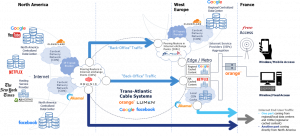This blog is second in a series of three blogs related to Content Distribution. The first blog post can be found here.
In a previous post, we have examined the end-to-end content delivery chain and listed the main parties contributing to it, with the objective to move data from locations where contents are produced or stored to locations where end-users reside.
In this post, we will take a look at where the various parties involved in this content delivery chain are physically located and how they interconnect to each other. Also, the role of subsea cable systems in this architecture will be described.
Like in the previous post, we have assumed contents produced/stored in the US and end-users based in France with the parties involved in the end-to-end delivery chain as exampled in the Figure below (only one party in each category/column is involved in a specific content storage location to end user connectivity).

Parties involved in the end-to-end content delivery chain
How do these parties map in the real world and how do they interconnect to each other for actually moving the data to its final destination? The Figure below is an attempt to answer both questions.
On the left side, we find the content producers in the US. The content of the New York Times newspaper is assumed to be hosted by A2 Hosting, a US-based website hosting provider. Larger content producers, like Google for YouTube video platform, Facebook for social networking services and Netflix for video streaming services, will use larger data centers to store their content. The largest content providers will build and operate their own data centers, while smaller content providers may rent space in data centers operated by another company.
Depending on their size and the network infrastructure they do or do not own, content providers may use third-party network infrastructure to connect to trans-Atlantic cable systems and move the data to west Europe. For instance, a small content player like the New York Times will see its content hosted by A2 Hosting transported first by a regional network operator (e.g., an internet service provider or a domestic carrier) before being handed over to an international carrier that will move the data from a US point of presence to a west Europe point of presence over a trans-Atlantic cable system. The Figure below assumes that the regional network provider and the trans-Atlantic cable system operator will interconnect in an Internet eXchange Point (IXP) housed by an Equinix data center. IXP locations exist on the “edge” of different networks and allow network providers to share transit outside their own network.

(Simplified) Physical view of the end-to-end content delivery chain
Assuming the New York Times content will be transported over trans-Atlantic fiber pairs operated by Orange, the data will land in a French cable landing station and be delivered to the end-users through the ISP network operated by Orange, with direct access to the end-users via fixed or mobile broadband connection.
The largest content providers, like Facebook and Google, will operate their own transport infrastructure in the US and across the Atlantic Ocean. On the European side, they may need to rely on a Content Delivery Network (CDN) operator that will move the data (and cache the most popular contents) closer to the end users. The last mile will be carried out by a local ISP via an interconnection between the CDN and ISP networks in an edge data center. Some of the major content providers have built more than 5,000 edge caching locations worldwide to offer content as close as possible to the end-users to improve the quality of experience.
The figure above shows three arrows across the Atlantic Ocean. Each of the arrow corresponds to a specific type of traffic. The top arrow moves data between massive data centers located in the US and west Europe for content replication and synchronization. The data centers located in west Europe can then feed regional data centers and the content will be accessed by European end-users via local network and service providers. The mid arrow moves data between massive data centers in the US and smaller data centers built close to some west European population centers (for instance, edge data centers) in order to store the most popular static content close to the end-users. The bottom arrow moves data from massive data centers in the US directly to some west European IXPs where regional ISPs connect to collect and move the data to satisfy end-user requests.
The proportions of the contents moved within the region and/or cached in the region (designated as “back-office traffic” in the Figure above) and the content moved directly from the US to the end-users (dark blue, bottom-arrow traffic) can be very unbalanced in well-developed markets like the trans-Atlantic route.
In a next post, we will take a look at the evolution of the role of the parties involved in the end-to-end content delivery chain.
For comments or questions, please contact us.
